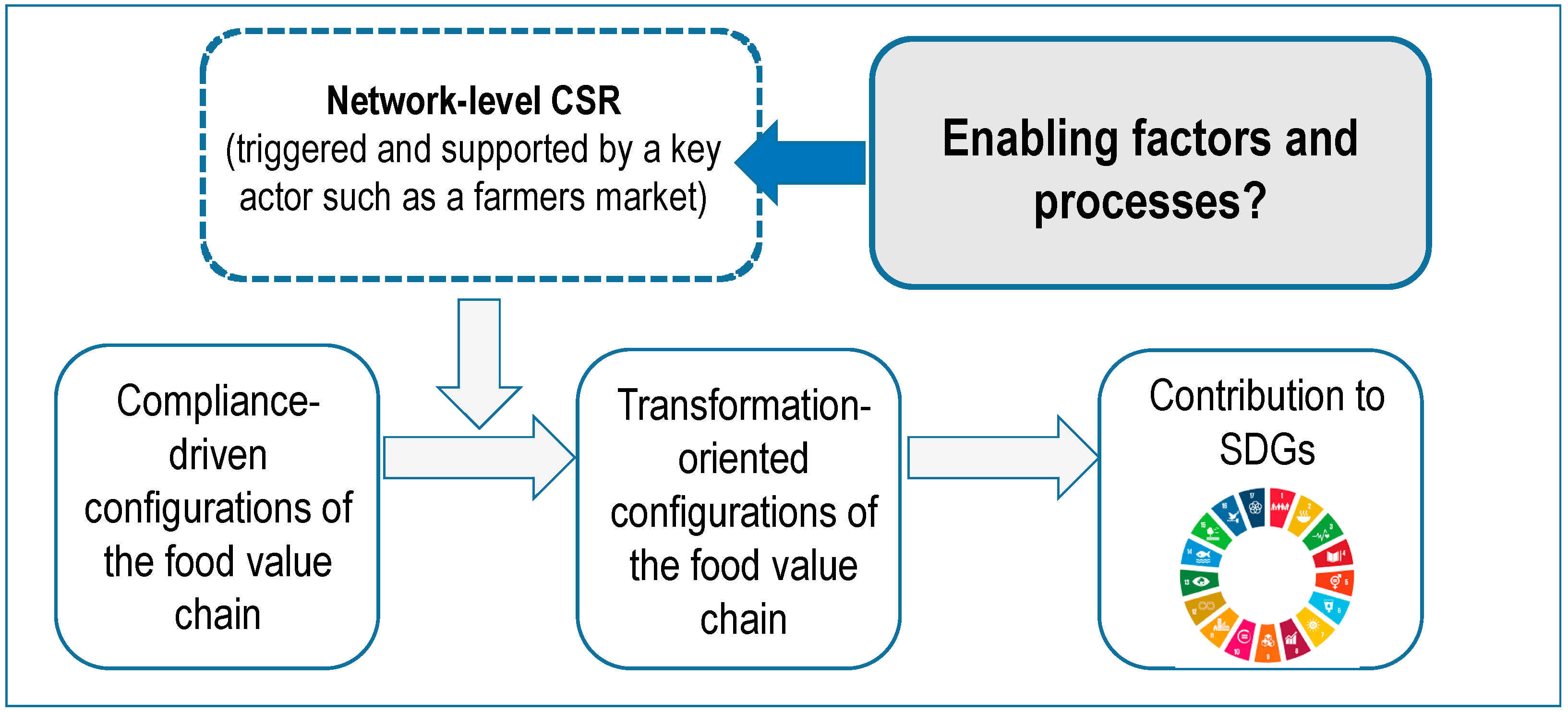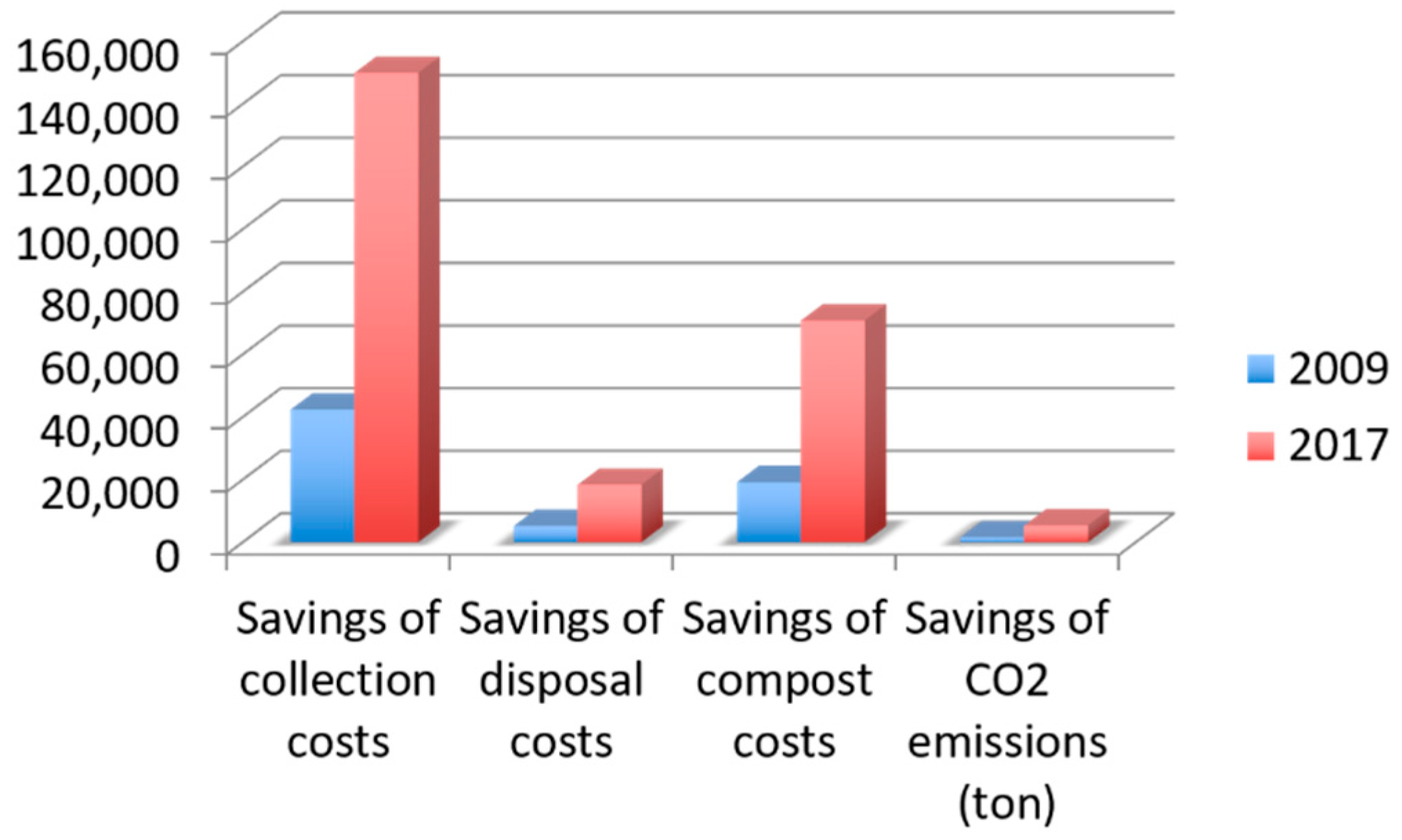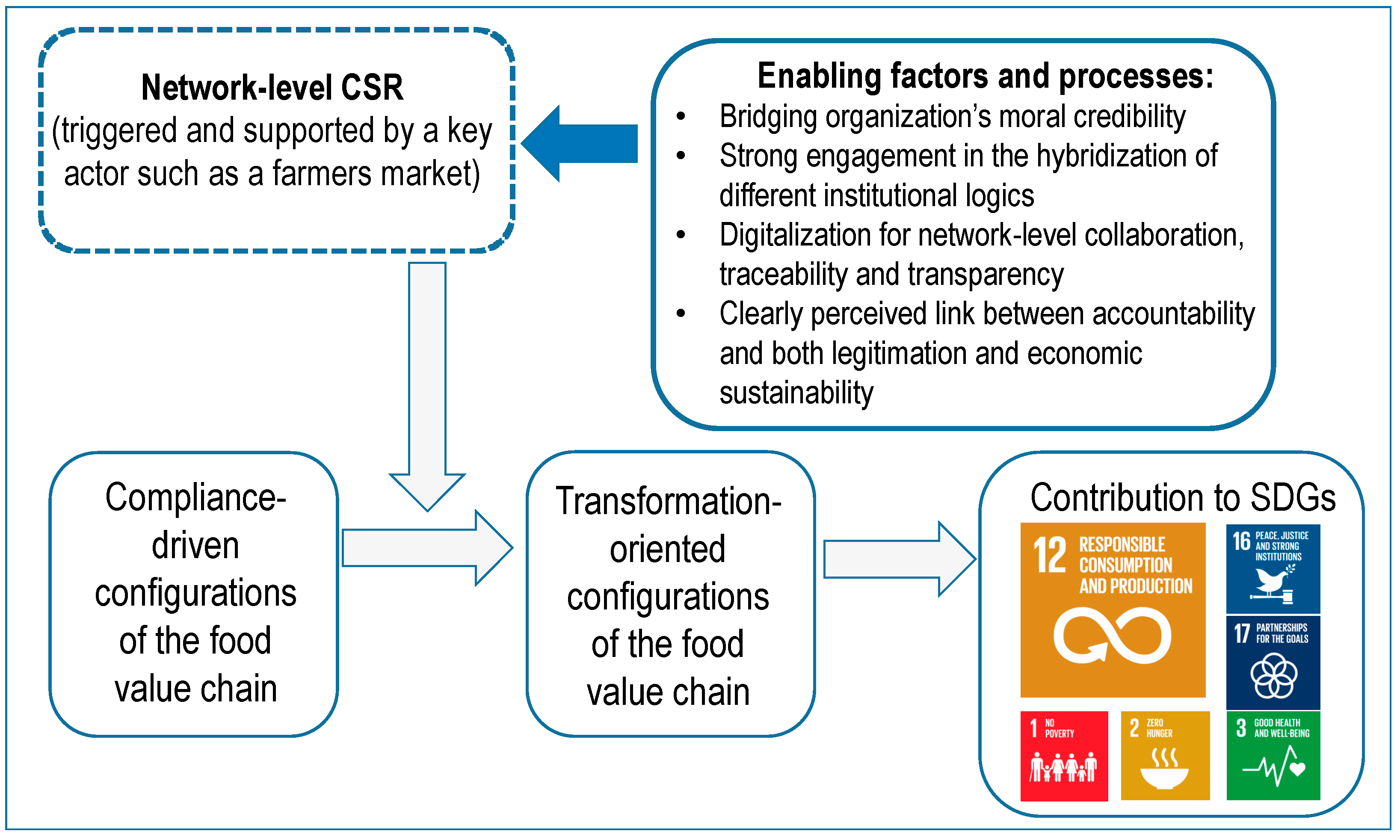Against Food Waste: CSR for the Social and Environmental Impact through a Network-Based Organizational Model
Abstract
:1. Introduction
2. Background
2.1. Food Waste: A Multi-Faceted Sustainability Challenge
2.2. Food Waste and Corporate Social Responsibility
2.3. Different Trajectories of CSR: Façade Solutions or Sustainability Transformation Processes?
3. Methodology
3.1. A Longitudinal Case Study
3.2. Research Setting
4. CSR Practices in the Rainbow Market Case: Developmental Phases
4.1. Informal Donation and Façade Solutions (before 2008)
4.2. Networking and Problem Articulation (2008)
4.3. Experimentation of a New Network-Based Integrated Activity System (2008–2009)
4.4. Field-Level Institutionalization: The Role of Accounting, Accountability and Auditing on CSR Actions (Since 2010)
5. Discussion
6. Conclusions
Author Contributions
Funding
Conflicts of Interest
Appendix A. Semi-Structured Interview Guide
- Collect some soft and general background information, to overcome the broken-ice phase and facilitate the engage in general conversation on interviewee’s organization and his/her role.
- Could you describe the context in which your organization operated?
- In your opinion, why your organization have decided to join the food waste project?
- Why do you believe your organization engages in food waste reduction (if relevant)?
- Discuss your organization’s experience into the food waste project?
- Could you explain the main consequence on the day-by-day operation, due to the food waste project?
- 7.
- What are the roles played by the different organizations inside the network?
- 8.
- Could you explain how do you share sources, knowledge and materials among participants? How the network manages this sharing?
- 9.
- The project involved the entire food waste supply chain. How do you manage the relationship with (according to the interviewee)?
- Municipalities
- For profit organizations
- Nonprofit organizations
- The ASP
- Farmers market
- Local community
- 10.
- How engaging with the food waste project has changed the relationships with these stakeholders?
- 11.
- How are you monitoring the impacts of the project on your organization (e.g., on efficiency, effectiveness, costs, etc.)
- Social
- Economic
- Environmental
- 12.
- How do you present these results?
- 13.
- What tools have your organization developed to disclose these results (if applicable)?
- 14.
- Why, in your opinion, is this disclosure provided?
- 15.
- The researcher asks if any clarification is required.
Appendix B
| N | Organization | Role | Role | Year | Network | Accountability | Engagement | Bridging Organization |
|---|---|---|---|---|---|---|---|---|
| 1 | Rainbow Market | Wholesaler | President of Rainbow Market | 2016 | ✓ | ✓ | ✓ | ✓ |
| 2 | Rainbow Market | Politician | President of Farmers’ market | 2011, 2018 | ✓ | ✓ | ✓ | ✓ |
| 1 | Rainbow Market | Employee | Director | 2011, 2018 | ✓ | ✓ | ✓ | ✓ |
| 1 | Rainbow Market | Employee | Inspector | 2013 | ✓ | ✓ | ✓ | |
| 1 | ASP | Volunteer | Accountant | 2011, 2018 | ✓ | ✓ | ✓ | |
| 1 | ASP | Freelance professional | Project manager | 2011, 2014 | ✓ | ✓ | ✓ | ✓ |
| 1 | Municipality | Politician | Social services council member | 2015 | ✓ | ✓ | ✓ | |
| 1 | Municipality | Politician | Social services council member | 2015 | ✓ | ✓ | ✓ | |
| 1 | Local Health service | Employee | Director | 2013 | ✓ | ✓ | ✓ | ✓ |
| 5 | Nonprofit organizations | Employees/volunteers | Various | 2016 | ✓ | ✓ | ✓ | ✓ |
References
- Jurgilevich, A.; Birge, T.; Kentala-Lehtonen, J.; Korhonen-Kurki, K.; Pietikäinen, J.; Saikku, L.; Schösler, H. Transition towards Circular Economy in the Food System. Sustainability 2016, 8, 69. [Google Scholar] [CrossRef]
- United Nations. Transforming Our World: The 2030 Agenda for Sustainable Development-A/RES/70/1; United Nations: New York, NY, USA, 2015. [Google Scholar]
- European Commission. Closing the Loop—An EU Action Plan for the Circular Economy—COM (2015) 614 Final; European Commission: Brussels, Belgium, 2015. [Google Scholar]
- Bansal, P.; Clelland, I. Talking trash: Legitimacy, impression management, and unsystematic risk in the context of the natural environment. Acad. Manag. J. 2004, 47, 93–103. [Google Scholar] [CrossRef]
- Parfitt, J.; Barthel, M.; Macnaughton, S. Food waste within food supply chains: Quantification and potential for change to 2050. Philos. Trans. R. Soc. Lond. 2010, 365, 3065–3081. [Google Scholar] [CrossRef] [PubMed]
- Foley, J.A.; Ramankutty, N.; Brauman, K.A.; Cassidy, E.S.; Gerber, J.S.; Johnston, M.; Mueller, N.D.; O’Connell, C.; Ray, D.K.; West, P.C.; et al. Solutions for a cultivated planet. Nature 2011, 478, 337–342. [Google Scholar] [CrossRef] [PubMed] [Green Version]
- Garrone, P.; Melacini, M.; Perego, A. Opening the black box of food waste reduction. Food Policy 2014, 46, 129–139. [Google Scholar] [CrossRef]
- Martin, M.; Danielsson, L. Environmental Implications of Dynamic Policies on Food Consumption and Waste Handling in the European Union. Sustainability 2016, 8, 282. [Google Scholar] [CrossRef]
- Papargyropoulou, E.; Lozano, R.; Steinberger, J.K.; Wright, N.; Bin Ujang, Z. The food waste hierarchy as a framework for the management of food surplus and food waste. J. Clean. Prod. 2014, 76, 106–115. [Google Scholar] [CrossRef] [Green Version]
- Buzby, J.C.; Hyman, J. Total and per capita value of food loss in the United States. Food Policy 2012, 37, 561–570. [Google Scholar] [CrossRef]
- Lanfranchi, M.; Giannetto, C.; De Pascale, A. Analysis and models for the reduction of food waste in organized large-scale retail distribution in eastern Sicily. Am. J. Appl. Sci. 2014, 11, 1860–1870. [Google Scholar] [CrossRef]
- Goggins, G.; Rau, H. Beyond calorie counting: Assessing the sustainability of food provided for public consumption. J. Clean. Prod. 2016, 112, 257–266. [Google Scholar] [CrossRef]
- Reutter, B.; Lant, P.; Reynolds, C.; Lanea, J. Food waste consequences: Environmentally extended input-output as a framework for analysis. J. Clean. Prod. 2016, 153, 506–514. [Google Scholar] [CrossRef]
- Lundie, S.; Peters, G.M. Life cycle assessment of food waste management options. J. Clean. Prod. 2005, 13, 275–286. [Google Scholar] [CrossRef]
- Bernstad, A.; La Cour Jansen, J. Review of comparative LCAs of food waste management systems–current status and potential improvements. Waste Manag. 2012, 32, 2439–2455. [Google Scholar] [CrossRef] [PubMed]
- Eriksson, M.; Strid, I.; Hansson, P.A. Carbon footprint of food waste management options in the waste hierarchy—A Swedish case study. J. Clean. Prod. 2015, 93, 115–125. [Google Scholar] [CrossRef]
- Sala, S.; McLaren, S.J.; Notarnicola, B.; Saouter, E.; Sonesson, U. In quest of reducing the environmental impacts of food production and consumption. J. Clean. Prod. 2017, 140, 387–398. [Google Scholar] [CrossRef]
- Markard, J.; Raven, R.; Truffer, B. Sustainability transitions: An emerging field of research and its prospects. Res. Policy 2012, 41, 955–967. [Google Scholar] [CrossRef]
- Scholz, K.; Eriksson, M.; Strid, I. Carbon footprint of supermarket food waste. Resour. Conserv. Recycl. 2014, 94, 56–65. [Google Scholar] [CrossRef]
- Ferraro, F.; Etzion, D.; Gehman, J. Tackling Grand Challenges Pragmatically: Robust Action Revisited. Org. Stud. 2015, 36, 363–390. [Google Scholar] [CrossRef] [Green Version]
- Heugens, P.P.M.A.R.; Lander, M.W. Structure! agency! (and other quarrels): A meta-analysis of institutional theories of organization. Acad. Manag. J. 2009, 52, 61–85. [Google Scholar] [CrossRef]
- Redman, E.; Redman, A. Transforming sustainable food and waste behaviors by realigning domains of knowledge in our education system. J. Clean. Prod. 2014, 64, 147–157. [Google Scholar] [CrossRef] [Green Version]
- Suchman, M.C. Managing Legitimacy: Strategic and Institutional Approaches. Acad. Manag. Rev. 1995, 20, 571–610. [Google Scholar] [CrossRef]
- Soobaroyen, T.; Devi, M.J. Community disclosures in a developing country: Insights from a neo-pluralist perspective. Account. Audit. Account. J. 2016, 29, 452–482. [Google Scholar] [CrossRef]
- Devin, B.; Richards, C. Food waste, power, and corporate social responsibility in the Australian food supply chain. J. Bus. Ethics 2016, 150, 1–12. [Google Scholar] [CrossRef]
- Food and Agriculture Organization of United Nations (FAO). Global Initiative on Food Losses and Waste Reduction; UN Food and Agriculture Organization: Rome, Italy, 2014. [Google Scholar]
- Food and Agriculture Organization of United Nations (FAO). Global Food Losses and Food Waste—Extent, Causes and Prevention; UN Food and Agriculture Organization: Rome, Italy, 2011. [Google Scholar]
- Bonomi, S.; Ricciardi, F.; Rossignoli, C. Network organisations for externality challenges: How social entrepreneurship co-evolves with ICT-enabled solutions. Int. J. Knowl. Based Dev. 2017, 8, 346–366. [Google Scholar] [CrossRef]
- Bonomi, S.; Ricciardi, F.; Rossignoli, C. Organizational engines for smart territorial network: The case of an iniziative for food waste reduction. In Blurring the Boundaries through Digital Innovation. Individual, Organizational, and Societal Challenges; Dascenzo, F., Magni, M., Lazazzara, A., Za, S., Eds.; Springer: London, UK, 2016. [Google Scholar]
- Mainali, B.; Luukkanen, J.; Silveira, S.; Kaivo-oja, J. Evaluating Synergies and Trade-Offs among Sustainable Development Goals (SDGs): Explorative Analyses of Development Paths in South Asia and Sub-Saharan Africa. Sustainability 2017, 10, 815. [Google Scholar] [CrossRef]
- United Nations. 2018 HLPF Review of SDGs Implementation: SDG 12—Ensure Sustainable Consumption and Production Patterns; United Nations: New York, NY, USA, 2018. [Google Scholar]
- Bebbington, J.; Russell, S.; Thomson, I. Accounting and sustainable development: Reflections and propositions. Crit. Perspect. Account. 2017, 48, 21–34. [Google Scholar] [CrossRef]
- Booth, S.; Whelan, J. Hungry for change: The food banking industry in Australia. Br. Food J. 2014, 116, 1392–1404. [Google Scholar] [CrossRef]
- Mirabella, N.; Castellani, V.; Sala, S. Current options for the valorization of food manufacturing waste: A review. J. Clean. Prod. 2014, 65, 28–41. [Google Scholar] [CrossRef]
- Sgarbossa, F.; Russo, I. A proactive model in sustainable food supply chain: Insight from a case study. Int. J. Prod. Econ. 2017, 183, 596–606. [Google Scholar] [CrossRef]
- Wood, D.J. Corporate Social Performance Revisited. Acad. Manag. Rev. 1991, 16, 691–718. [Google Scholar] [CrossRef]
- European Commission. COM(2011) 681 Final—A Renewed EU Strategy 2011–2014 for Corporate Social Responsibility; European Commission: Brussels, Belgium, 2011. [Google Scholar]
- Moggi, S.; Leardini, C.; Rossi, G.; Alessandro, Z. Meeting Local Community Needs. A Dashboard from the Stakeholder Engagement Experience; Working Paper n. 16; Vita e Pensiero: Milan, Italy, 2016. [Google Scholar]
- Jones, P.; Comfort, D.; Hillier, D.; Eastwood, I. Corporate social responsibility: A case study of the UK’s leading food retailers. Br. Food J. 2005, 107, 423–435. [Google Scholar] [CrossRef]
- Seifi, S.; Zulkifli, N.; Yusuff, R.; Sullaiman, S. Information requirements for sustainable consumption. Soc. Respir. J. 2012, 8, 433–441. [Google Scholar] [CrossRef]
- International Organization for Standardization (ISO). 26000 Guidance on Social Responsibility; ISO: Ginebra, Colombia, 2010. [Google Scholar]
- Bowen, H.R. Social Responsibilities of the Businessman; Harper & Row: New York, NY, USA, 1953. [Google Scholar]
- Davis, K. Can business afford to ignore social responsibilities? Calif. Manag. Rev. 1960, 2, 70–76. [Google Scholar] [CrossRef]
- Carroll, A.B. A three-dimensional conceptual model of corporate performance. Acad. Manag. Rev. 1979, 4, 497–505. [Google Scholar] [CrossRef]
- Carroll, A.B. Corporate social responsibility: Evolution of a definitional construct. Bus. Soc. 1999, 38, 268–295. [Google Scholar] [CrossRef]
- Engle, R.L. Corporate social responsibility in host countries: A perspective from American managers. Corp. Soc. Responsib. Environ. Manag. 2007, 14, 16–27. [Google Scholar] [CrossRef]
- Dowling, J.; Pfeffer, J. Organizational Legitimacy: Social Values and Organizational Behavior. Pac. Soc. R. 1975, 18, 122–136. [Google Scholar] [CrossRef]
- Luhmann, H.; Theuvsen, L. Corporate social responsibility in agribusiness: Literature review and future research directions. J. Agric. Environ. Ethics 2016, 29, 673–696. [Google Scholar] [CrossRef]
- Hartmann, M. Corporate social responsibility in the food sector. Eur. Rev. Agric. Econ. 2011, 38, 297–324. [Google Scholar] [CrossRef]
- Canali, M.; Amani, P.; Aramyan, L.; Gheoldus, M.; Moates, G.; Östergren, K.; Vittuari, M. Food waste drivers in Europe, from identification to possible interventions. Sustainability 2016, 9, 37. [Google Scholar] [CrossRef]
- Fuchs, D.; Kalfagianni, A. Discursive power as a source of legitimation in food retail governance. Int. Rev. Retail Distrib. Consum. Res. 2009, 19, 553–570. [Google Scholar] [CrossRef]
- Forsman-Hugg, S.; Katajajuuri, J.M.; Riipi, I.; Mäkelä, J.; Järvelä, K.; Timonen, P. Key CSR dimensions for the food chain. Br. Food J. 2013, 115, 30–47. [Google Scholar] [CrossRef]
- Maloni, M.J.; Brown, M.E. Corporate social responsibility in the supply chain: An application in the food industry. J. Bus. Ethics 2006, 68, 35–52. [Google Scholar] [CrossRef]
- Anselmsson, J.; Johansson, U. Corporate social responsibility and the positioning of grocery brands: An exploratory study of retailer and manufacturer brands at point of purchase. Int. J. Retail Distrib. Manag. 2007, 35, 835–856. [Google Scholar] [CrossRef]
- Wiese, A.; Toporowski, W. CSR failures in food supply chains—An agency perspective. Br. Food J. 2013, 115, 92–107. [Google Scholar] [CrossRef]
- Crowther, D.; Seifi, S.; Moyeen, A. Responsibility and Governance in Achieving Sustainability. In The Goals of Sustainable Development; Springer: Singapore, 2018. [Google Scholar]
- Wooten, M.; Hoffman, A.J. Organizational Fields: Past, Present, and Future. In The Sage Handbook of Organizational Institutionalism; Greenwood, R., Oliver, C., Meyer, R.E., Lawrence, T., Eds.; Sage: Los Angeles, CA, USA, 2017; pp. 130–147. [Google Scholar]
- Glynn, M.A. Theorizing the identity-institution relationship: Considering identity as antecedent to, consequence of, and mechanism for, processes of institutional change. In The Sage Handbook of Organizational Institutionalism; Greenwood, R., Oliver, C., Meyer, R.E., Lawrence, T., Eds.; Sage: Los Angeles, CA, USA, 2017; pp. 243–258. [Google Scholar]
- Lounsbury, M.; Ventresca, M.; Hirsch, P.M. Social movements, field frames and industry emergence: A cultural–political perspective on US recycling. Socio-Econ. Rev. 2003, 1, 71–104. [Google Scholar] [CrossRef]
- Wijen, F. Means versus ends in opaque institutional fields: Trading off compliance and achievement in sustainability standard adoption. Acad. Manag. Rev. 2014, 39, 302–323. [Google Scholar] [CrossRef] [Green Version]
- Davis, G.F.; Marquis, C. Prospects for organization theory in the early twenty-first century: Institutional fields and mechanisms. Org. Sci. 2005, 16, 332–343. [Google Scholar] [CrossRef]
- Powell, W.W.; White, D.R.; Koput, K.W.; Owen-Smith, J. Network dynamics and field evolution: The growth of interorganizational collaboration in the life sciences. Am. J. Soc. 2005, 110, 1132–1205. [Google Scholar] [CrossRef]
- Zietsma, C.; Lawrence, T.B. Institutional work in the transformation of an organizational field: The interplay of boundary work and practice work. Admin. Sci. Q. 2010, 55, 189–221. [Google Scholar] [CrossRef]
- Furnari, S. Interstitial spaces: Microinteraction settings and the genesis of new practices between institutional fields. Acad. Manag. 2014, 39, 439–462. [Google Scholar] [CrossRef]
- Furnari, S. Institutional fields as linked arenas: Inter-field resource dependence, institutional work and institutional change. Hum. Relat. 2016, 69, 551–580. [Google Scholar] [CrossRef] [Green Version]
- Pache, A.C.; Santos, F. When worlds collide: The internal dynamics of organizational responses to conflicting institutional demands. Acad. Manag. Rev. 2010, 35, 455–476. [Google Scholar]
- Thornton, P.H.; Ocasio, W.; Lounsbury, M. The Institutional Logics Perspective: Foundations, Research, and Theoretical Elaboration; Oxford University Press: Oxford, UK, 2012. [Google Scholar]
- Dorado, S. Institutional entrepreneurship, partaking, and convening. Org. Stud. 2005, 26, 385–414. [Google Scholar] [CrossRef]
- Wijen, F.; Ansari, S. Overcoming inaction through collective institutional entrepreneurship: Insights from regime theory. Org. Stud. 2007, 28, 1079–1100. [Google Scholar] [CrossRef]
- Battilana, J.; Leca, B.; Boxenbaum, E. How Actors Change Institutions: Towards a Theory of Institutional Entrepreneurship. Acad. Manag. Ann. 2009, 3, 65–107. [Google Scholar] [CrossRef]
- Santos, F.M. A positive theory of social entrepreneurship. J. Bus. Ethics 2012, 111, 335–351. [Google Scholar] [CrossRef]
- Zhao, E.Y.; Lounsbury, M. An institutional logics approach to social entrepreneurship: Market logic, religious diversity, and resource acquisition by microfinance organizations. J. Bus. Ventur. 2016, 31. [Google Scholar] [CrossRef]
- Eisenhardt, K.M.; Graebner, M.E.; Sonenshein, S. Grand Challenges and Inductive Methods: Rigor without Rigor Mortis. Acad. Manag. J. 2016, 59, 1113–1123. [Google Scholar] [CrossRef]
- Stake, R.E. Multiple Case Study Analysis; Guilford Press: New York, NY, USA, 2013. [Google Scholar]
- Bryman, A.; Bell, E. Business Research Methods; Oxford University Press: Oxford, UK, 2011. [Google Scholar]
- Denzin, N.K. The Research Act: A Theoretical Introduction to Sociological Methods; McGraw-Hill: New York, NY, USA, 1978. [Google Scholar]
- Patton, M.Q. Qualitative Research & Evaluation Methods; Sage: London, UK, 2002. [Google Scholar]
- Sherman Heyl, B. Ethnographic interviewing. In Handbook of Ethnography; Atkinson, P., Coffey, A., Delamont, S., Lofland, J., Lofland, L., Eds.; Sage: London, UK, 2001; pp. 369–379. [Google Scholar]
- Miles, M.B.; Huberman, A.M. Qualitative Data Analysis; Sage: London, UK, 1994. [Google Scholar]
- Creswell, J.W. Research Design: Qualitative, Quantitative, and Mixed Methods Approaches; Sage: London, UK, 2003. [Google Scholar]
- Miles, M.B.; Huberman, A.M.; Saldaña, J. Qualitative Data Analysis: A Methods Sourcebook; Sage: London, UK, 2014. [Google Scholar]
- Bonomi, S.; Ricciardi, F. Trasformare lo spreco alimentare in risorsa sociale: Una soluzione organizzativa (Transforming food waste in a social resource. An organizational solution). Impresa Progetto 2017, 2, 1–20. [Google Scholar]
- Jay, J. Navigating paradox as a mechanism of change and innovation in hybrid organizations. Acad. Manag. J. 2013, 56, 137–159. [Google Scholar] [CrossRef]




© 2018 by the authors. Licensee MDPI, Basel, Switzerland. This article is an open access article distributed under the terms and conditions of the Creative Commons Attribution (CC BY) license (http://creativecommons.org/licenses/by/4.0/).
Share and Cite
Moggi, S.; Bonomi, S.; Ricciardi, F. Against Food Waste: CSR for the Social and Environmental Impact through a Network-Based Organizational Model. Sustainability 2018, 10, 3515. https://doi.org/10.3390/su10103515
Moggi S, Bonomi S, Ricciardi F. Against Food Waste: CSR for the Social and Environmental Impact through a Network-Based Organizational Model. Sustainability. 2018; 10(10):3515. https://doi.org/10.3390/su10103515
Chicago/Turabian StyleMoggi, Sara, Sabrina Bonomi, and Francesca Ricciardi. 2018. "Against Food Waste: CSR for the Social and Environmental Impact through a Network-Based Organizational Model" Sustainability 10, no. 10: 3515. https://doi.org/10.3390/su10103515
APA StyleMoggi, S., Bonomi, S., & Ricciardi, F. (2018). Against Food Waste: CSR for the Social and Environmental Impact through a Network-Based Organizational Model. Sustainability, 10(10), 3515. https://doi.org/10.3390/su10103515






